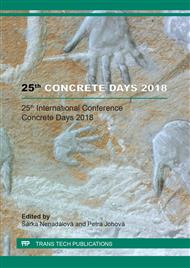p.85
p.91
p.96
p.102
p.108
p.114
p.123
p.128
p.134
Macroscopic and Microscopic Properties of High Performance Concrete with Partial Replacement of Cement by Fly Ash
Abstract:
The paper describes an experimental program focused on the research of high performance concrete with partial replacement of cement by fly ash. Four mixtures were investigated: reference mixture and mixtures with 10 %, 20 % and 30 % cement weight replaced by fly ash. In the first stage, the effect of cement replacement was observed. The second phase aimed at the influence of homogenization process for the selected 30% replacement on concrete properties. The analysis of macroscopic properties followed compressive strength, elastic modulus and depth of penetration of water under pressure. Microscopic analysis concentrated on the study of elastic modulus, porosity and mineralogical composition of cement matrix using scanning electron microscopy, spectral analysis and nanoindentation. The macroscopic results showed that the replacement of cement by fly ash notably improved compressive strength of concrete and significantly decreased the depth of penetration of water under pressure, while the improvement rate increased with increasing cement replacement (strength improved by 18 %, depth of penetration by 95 % at 30% replacement). Static elastic modulus was practically unaffected. Microscopic investigation showed impact of fly ash on both structure and phase mechanical performance of the material.
Info:
Periodical:
Pages:
108-113
Citation:
Online since:
June 2019
Authors:
Keywords:
Price:
Сopyright:
© 2019 Trans Tech Publications Ltd. All Rights Reserved
Share:
Citation:


